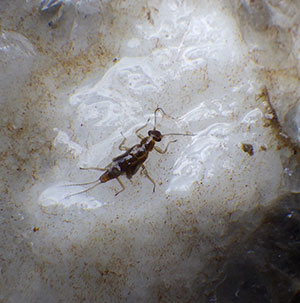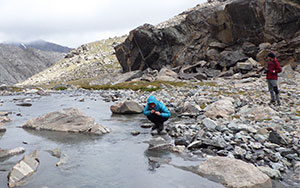UW Leads Research That Finds Western Glacier Stoneflies in New Wyoming Locations
Published May 13, 2022

A group of researchers, led by the University of Wyoming, recently discovered the western glacier stonefly -- Wyoming’s only insect protected under the Endangered Species Act -- has a range wider than previously known.
Lusha Tronstad, lead invertebrate zoologist with the Wyoming Natural Diversity Database (WYNDD) at UW, led the research, which took place in Wyoming the past two summers with funding from Region 2 of the U.S. Forest Service.
The western glacier stonefly, or Zapada glacier, is known from two areas in Montana -- Glacier National Park and the Beartooth Mountains -- and one area in Wyoming, the Teton Range. However, the latest research discovered the western glacier stonefly in eight separate cold streams located below glaciers in the Beartooth, Absaroka and Wind River ranges.
“This is a range extension, and this information will be used for the recovery plan for this species,” Tronstad says. “This is big news, because this protected stonefly was only known from three areas previously, and we found it in two new mountain ranges (Absaroka and Wind River) in Wyoming. Our data will directly influence management decisions.”
Tronstad stresses that WYNDD only supplies the data and does not have any role in management decisions.
Tronstad was lead author of the paper “Are Western Glacier Stoneflies (Zapada glacier) More Widely Distributed in Wyoming Alpine Streams?” that was written for the U.S. Forest Service and published April 28.
Bryan Tronstad, an assistant invertebrate zoologist with WYNDD; Audrey Lindsteadt, a WYNDD technician and a soon-to-be UW graduate student from St. Joseph, Mo.; and Scott Hotaling, with Utah State University’s Department of Watershed Sciences, also contributed to the paper. Bryan Tronstad collected and processed samples and identified the invertebrates. Lindsteadt collected samples and prepared insect samples for DNA barcoding, which is the only way to identify larval western glacier stoneflies. Hotaling analyzed the DNA barcoding results.
“We did surveys in the Big Horn, Beartooth, Absaroka, Wind River and Snowy (Range) mountains of Wyoming, surveying alpine streams draining cold water sources,” Lusha Tronstad says. “We discovered the western glacier stonefly in eight streams in the Beartooth, Absaroka and Wind River mountains. These are areas that were previously unknown, and seven streams were distant from known populations of the stonefly. Our study expanded the range of this threatened species.”

Alpine streams sampled for the insect included surface glacier, rock glacier, springs and snowmelt. The genus of stonefly was collected in 60 percent of the streams sampled. But the species was only found in eight streams that originated from surface glaciers and rock glaciers. Streams fed by rock glaciers had the widest range of invertebrate biomass and richness, or the number of taxa collected. Rock and surface glacier streams had the coldest water temperatures, and rock glacier-fed streams had the highest specific conductivity, which is the concentration of salts or ions in water.
“Rock glaciers -- think of a surface glacier covered with rock debris -- are thought to persist longer on the landscape because the ice is insulated from the atmosphere,” Lusha Tronstad says. “Surface glaciers are predicted to disappear during the next century due to increasing air temperatures, but streams draining rock glaciers are hypothesized to persist longer. Streams draining rock glaciers may be refugia for cold-adapted insects, such as the western glacier stonefly.”
Lusha Tronstad says she thinks further surveys dedicated to looking for the western glacier stonefly in Wyoming and Montana “have a good probability of finding more populations.”
About WYNDD
WYNDD offers the most complete source of data for species and vegetation communities of management concern in Wyoming. Its mission is threefold: Identify and rank species that are priorities for management in Wyoming; amass existing data and develop new data for species needing management efforts, and for Wyoming vegetation types; and distribute these data upon request, under the philosophy that the best decisions regarding natural resources will be made only when everyone has access to complete and current scientific data.

